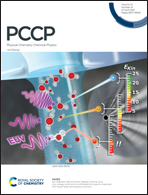Negative linear compressibility in nanoporous metal–organic frameworks rationalized by the empty channel structural mechanism†
Abstract
Zinc squarate tetrahydrate (ZnC4O4·4H2O) and titanium oxalate trioxide dihydrate (Ti2(C2O4)O3·2H2O) are nanoporous metal–organic frameworks possessing empty channels in their crystal structures. The crystal structures and mechanical properties of these materials are studied using first principles solid-state methods based on Density Functional Theory. The results show that they exhibit the negative linear compressibility (NLC) and negative Poisson's ratio (NPR) phenomena. The absolute value of the negative compressibilities are significant and the range of pressure for which NLC effects are shown is very wide. The detailed study of the deformation of the crystal structures under pressure reveals that the NLC effect in these compounds can be rationalized using the empty channel structural mechanism. Under isotropic compression, the channels are elongated along the direction of minimum compressibiity, leading to NLC. Furthermore, under compression along the direction of minimum compressibity, the unit-cell volume increases leading to negative volumetric compressibilty. The effect of hydration on the NLC effect in titanium oxalate trioxide dihydrate is investigated by studying the parent compound titanium oxalate trioxide trihydrate (Ti2(C2O4)O3·3H2O). The NLC effect in this material is reduced due to the reinforcement of the walls of the structural channels.



 Please wait while we load your content...
Please wait while we load your content...